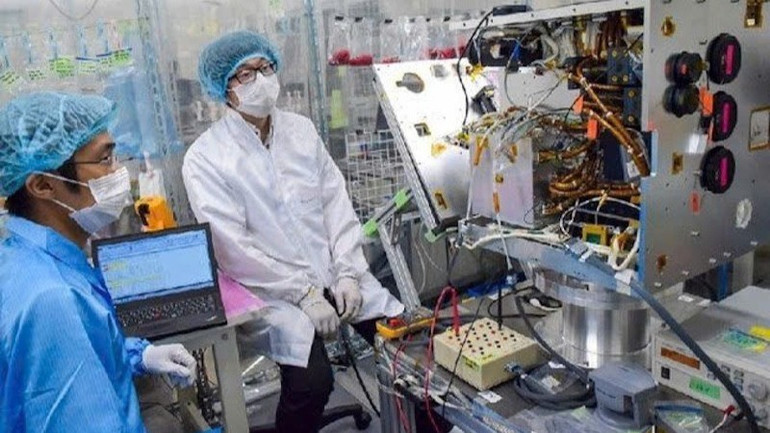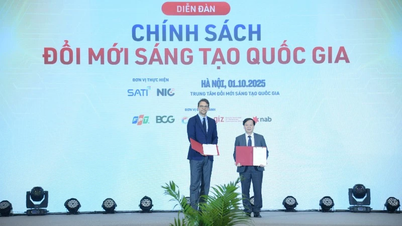Innovating management thinking, promoting the State's creative role
Effective from October 1, the Law on Science , Technology and Innovation, consisting of 7 Chapters and 73 Articles, strongly shifts from a pre-control model to a post-control model, focusing on process transparency, result assessment and risk management instead of deeply intervening in initial activities. This is a modern approach, consistent with the flexible and continuous experimental characteristics of the science, technology and innovation sector.
The scope of the law is also expanded to cover new organizational models, innovative production mechanisms and innovative management methods in both the public and private sectors.
For the first time, innovation has been included in the law, with a status equivalent to science and technology in the national legal system. This is a fundamental change in development thinking, demonstrating the view that innovation is a process of the whole people.

The law establishes a clear direction for the transition from a country that mainly uses technology to mastering strategic technologies, developing science and technology in a complete and balanced ecosystem.
In particular, the State plays a role in creating and investing in the construction of key laboratories and shared laboratories, supporting information, standards, intellectual property, issuing preferential financial mechanisms, supporting innovative enterprises, and attracting and rewarding domestic and foreign talents and experts. Coordination between entities will be strongly promoted to create a foundation for a strong and effective connection of the entire national innovation ecosystem.
In addition, the State's creative role is also demonstrated through the development of long-term development strategies and the transparent and flexible allocation of resources for science, technology and innovation tasks.
The Law clearly stipulates the roles and responsibilities of the Government, ministries, branches and local authorities in implementing science, technology and innovation policies. In particular, the initiative is given to provinces and cities to develop and operate science and technology programs in accordance with local socio -economic development conditions.
Promote application and increase transparency in intellectual property management
Notably, the law has removed a long-standing bottleneck related to the mechanism of ownership of research results using the State budget. Specifically, instead of having to ask for permission from the superior agency, the organization in charge of the research is automatically granted ownership or the right to use the research results. This is an important step forward to help promote practical application and increase transparency in intellectual property management.
The law also establishes a “sandbox” mechanism, a new legal tool that allows the implementation of new models, technologies or policies within a limited timeframe and scope, accepting the risks in research. This approach allows high-tech innovations such as artificial intelligence, blockchain, health technology and digital education to operate in a safe legal environment before widespread adoption.
At the same time, the law clearly demonstrates the principle of protecting scientists and host organizations when they follow the correct procedures and legal regulations, even if the results may not be as expected. This contributes to nurturing and inspiring the pioneering spirit of creativity and willingness to experiment among scientists.
Promoting comprehensive digital transformation to meet development requirements in the digital age
In the context of the fourth industrial revolution and the strong trend of digital transformation, the promulgation of the Law on Science, Technology and Innovation also lays the foundation for a sustainable data infrastructure, promotes the commercialization of research results, unlocks creative resources and creates new momentum for sustainable development.
Accordingly, the law establishes a digital platform and a national science, technology and innovation information system with the aim of enhancing data connectivity between research organizations, businesses and management agencies. Not only is it a management support tool, the data platform also plays a role in promoting comprehensive digital transformation throughout the industry. Through digitizing the management process, monitoring and evaluating science, technology and innovation activities, the law lays the foundation for a sustainable and flexible data infrastructure that meets development requirements in the digital age.
The Law promotes integration, sharing and synchronization between information systems, creating conditions for technology solutions to be deployed quickly, effectively and in the right direction.
The law also facilitates the development of an ecosystem to support commercialization with tools such as technology exchanges, intellectual property valuation organizations, transfer support centers, etc., helping to effectively connect research and production and business. Scientists are allowed to receive direct economic benefits from intellectual products, while the revenue sharing ratio is clearly regulated to ensure the harmony of interests between the parties.
The Law on Science, Technology and Innovation officially coming into force is expected to open up a new institutional space, promote social innovation, encourage research commercialization, effectively decentralize and link research with the market and life. This is an important step for Vietnam to transform from a country that mainly uses technology to mastering strategic technology, building a complete, modern and sustainable science and technology ecosystem.
Source: https://nhandan.vn/kien-tao-the-che-khoi-thong-dong-luc-phat-trien-khoa-hoc-cong-nghe-va-doi-moi-sang-tao-post912112.html



![[Photo] President of the Cuban National Assembly visits President Ho Chi Minh's Mausoleum](https://vphoto.vietnam.vn/thumb/1200x675/vietnam/resource/IMAGE/2025/10/1/39f1142310fc4dae9e3de4fcc9ac2ed0)

![[Photo] Keep your warehouse safe in all situations](https://vphoto.vietnam.vn/thumb/1200x675/vietnam/resource/IMAGE/2025/10/1/3eb4eceafe68497989865e7faa4e4d0e)
![[Photo] Hanoi morning of October 1: Prolonged flooding, people wade to work](https://vphoto.vietnam.vn/thumb/1200x675/vietnam/resource/IMAGE/2025/10/1/189be28938e3493fa26b2938efa2059e)

















































































Comment (0)